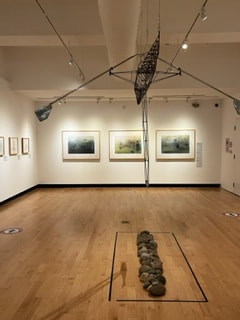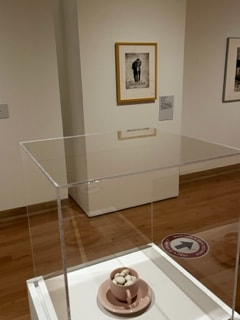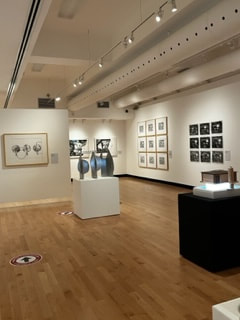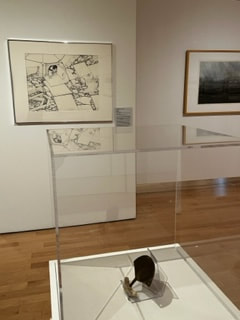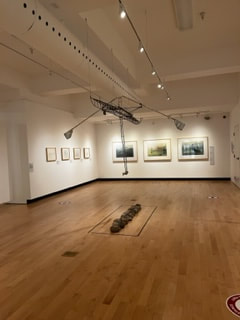Look Again: Form and Void
Works from the Permanent Collection
Woodstock Art Gallery
Look Again: Form and Void
Works from the Woodstock Art Gallery Permanent Collection
Malaya Akulukjuk Shuvina Ashoona Michael Belmore Ron Bolt Paul Fournier
Wyn Geleynse April Hickox Richard Percy Daniel Hicks David Hunsberger Barb Hunt
Elisapee Ishulutaq John Kissick Patrick Mahon Ron Milton Stuart Oxley Richard Prince
Gordon Rayner Don Russell Cole Swanson Patrick Thibert
Look Again is a study in representation. It examines how an artist creates form and volume using a minimal amount of colour, how the use of negative space enhances an image, and how repetition and slight variations in a series alter how we interpret and understand what we are looking at. The selected artworks have muted or monochromatic palettes, and many are pared down to a few lines or a single focused image or object. There are works that draw us in and require close scrutiny, and others that need us to step back in order to see the whole. Predominantly black and white abstract and figurative artworks demonstrate how lines, brushstrokes, composition and and subtle mark-making creates dynamic space, or forms an image, as we see in the works by Gordon Rayner, John Kissick, Malaya Akulukjuk, Elisapee Ishulutaq, Michael Belmore, Richard Prince. Paul Fournier, Don Russell, Richard Percy Daniel Hicks, and Ron Bolt.
The inclusion of objects expands our understanding of representation: Patrick Thibert’s portrait moves from the page into a structure, Michael Belmore and Ron Milton create tension between the found and depicted object, and the ulu knife from the art gallery’s collection is contextualized in Shuvina Ashoona’s drawing. An ulu knife is an all purpose tool used by Inuit women to do a variety of tasks from skinning and cleaning animals, to cutting child’s hair, to trimming blocks of snow and ice. Conceptually a relationship is established between the knife and April Hickox’s print that pushes back against gender stereotypes, and Barb Hunt’s sculpture that suggests the strangling of a woman’s voice. In proximity to these works we see Cole Swanson’s miniature drawing that is pinned like a butterfly and opens questions about laboratory practices and human-animal relations.
Using a subtle and muted palette Stuart Oxley’s works are permeated with light. Light is harnessed and made manifest in Wyn Geleynse’s magical sculpture. Weather and atmosphere are captured in Patrick Mahon’s series of Baker Lake House that expands the possibilities of printmaking as does David Hunsberger who lays out process in a way that draws attention to each mark and layer in the construction of an image. Be it abstract, figurative, landscape or conceptual, each work in the exhibition provides the opportunity to consider image and image-making, representation and the real, how an artist creates form, elicits response, or tells a story.
Works from the Woodstock Art Gallery Permanent Collection
Malaya Akulukjuk Shuvina Ashoona Michael Belmore Ron Bolt Paul Fournier
Wyn Geleynse April Hickox Richard Percy Daniel Hicks David Hunsberger Barb Hunt
Elisapee Ishulutaq John Kissick Patrick Mahon Ron Milton Stuart Oxley Richard Prince
Gordon Rayner Don Russell Cole Swanson Patrick Thibert
Look Again is a study in representation. It examines how an artist creates form and volume using a minimal amount of colour, how the use of negative space enhances an image, and how repetition and slight variations in a series alter how we interpret and understand what we are looking at. The selected artworks have muted or monochromatic palettes, and many are pared down to a few lines or a single focused image or object. There are works that draw us in and require close scrutiny, and others that need us to step back in order to see the whole. Predominantly black and white abstract and figurative artworks demonstrate how lines, brushstrokes, composition and and subtle mark-making creates dynamic space, or forms an image, as we see in the works by Gordon Rayner, John Kissick, Malaya Akulukjuk, Elisapee Ishulutaq, Michael Belmore, Richard Prince. Paul Fournier, Don Russell, Richard Percy Daniel Hicks, and Ron Bolt.
The inclusion of objects expands our understanding of representation: Patrick Thibert’s portrait moves from the page into a structure, Michael Belmore and Ron Milton create tension between the found and depicted object, and the ulu knife from the art gallery’s collection is contextualized in Shuvina Ashoona’s drawing. An ulu knife is an all purpose tool used by Inuit women to do a variety of tasks from skinning and cleaning animals, to cutting child’s hair, to trimming blocks of snow and ice. Conceptually a relationship is established between the knife and April Hickox’s print that pushes back against gender stereotypes, and Barb Hunt’s sculpture that suggests the strangling of a woman’s voice. In proximity to these works we see Cole Swanson’s miniature drawing that is pinned like a butterfly and opens questions about laboratory practices and human-animal relations.
Using a subtle and muted palette Stuart Oxley’s works are permeated with light. Light is harnessed and made manifest in Wyn Geleynse’s magical sculpture. Weather and atmosphere are captured in Patrick Mahon’s series of Baker Lake House that expands the possibilities of printmaking as does David Hunsberger who lays out process in a way that draws attention to each mark and layer in the construction of an image. Be it abstract, figurative, landscape or conceptual, each work in the exhibition provides the opportunity to consider image and image-making, representation and the real, how an artist creates form, elicits response, or tells a story.
